Dental Implants – Sherman, TX
Reliable Prosthetics Designed to Restore Smiles
Tooth loss can have devastating effects on a person’s ability to speak, eat, and smile. It can also lead to jawbone deterioration that can eventually cause more tooth loss, gum disease, and other serious oral and overall health problems. Dr. Mark, Dr. Grant, and Dr. Sharlenne want to help individuals avoid these issues by using dental implants in our Sherman, TX dental office. Considered the most superior form of tooth replacement available, these prosthetics do what no one other restorative solution can, which is restoring the complete root-to-crown tooth structure. Call us today to schedule a consultation and find out if dental implants are right for you.
Why Choose Grant E. & Mark A. Smith DDS for Dental Implants?
- Partner with Local Specialists
- Personalized Plans Based on Patients’ Needs
- Flexible Financing Available
What are Dental Implants?
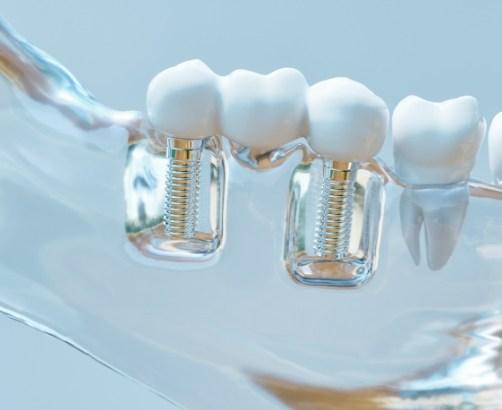
Dental implants are small, titanium, screw-like posts that fit into vacated sockets and fuse with the jawbone over time. Mimicking the roots of teeth, they work to stimulate the bone, preventing it from deteriorating and causing further tooth loss. On top of these implant posts are customized restorations, which can be dental crowns, bridges, or dentures depending on the number of teeth that are missing.
They are capable of remaining firmly in place for 30 years or even a lifetime depending on how well they are maintained, and patients can expect optimal functionality once they are put into place.
The 4-Step Dental Implants Process
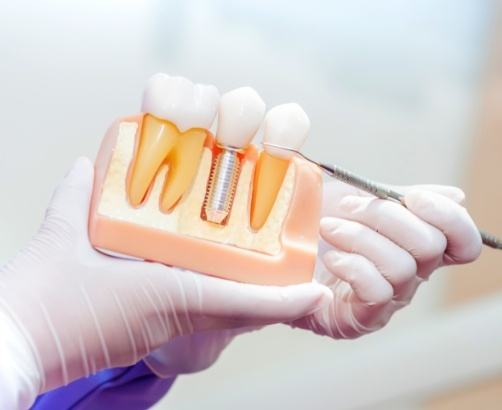
Dental implants are the preferred tooth replacement option by dentists and patients alike. Undergoing dental implant tooth placement requires patience, as it requires months of recovery before final restorations can be put into place. Although each person receives a different treatment plan based on their unique needs, the same four steps must be followed.
Initial Dental Implant Consultation

Patients meet with a member of our team to discuss candidacy as well as if any preliminary treatments are necessary (i.e., bone grafting, periodontal therapy, etc.). If any of these apply to you, we will help you get them scheduled. Once your gums and jawbone are in good condition, we can move onto planning the rest of your treatment. During this visit, we will go over the timeline and cost of your treatment as well as your financial options.
Dental Implant Surgery
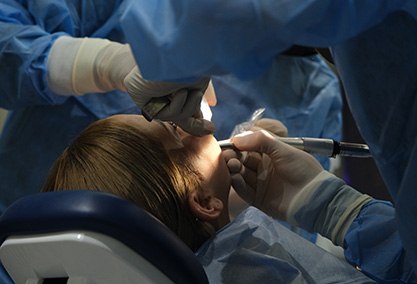
Our team will refer patients to a local specialist who will perform the actual dental implant surgery to ensure that everything goes as smoothly as possible. After the gums are opened, the dental implants are placed at precise locations throughout the jawbone. Then, the gums are closed and protective caps are placed over the ends of the implants to keep them safe as the area years.
Dental Implant Osseointegration & Abutment
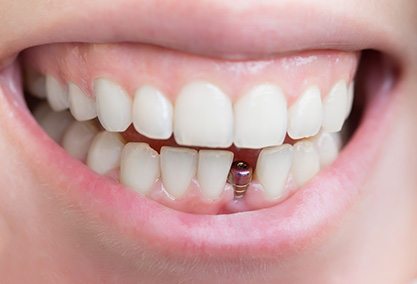
After surgery, patients are expected to enter the recovery phase, which can last anywhere from 3-6 months. This allows osseointegration to occur, which is the fusing of the bone and implant post. After you’re fully healed, you will receive your metal abutments, which are small connector appliances that will hold the restoration in place. Impressions are taken so your customized restoration can be crafted at the dental lab.
Delivery of Dental Implant Restoration(s)

After we receive your restorations, the final step is to receive the finished restoration, which will be secured to the top of the dental implants. If everything looks and feels great, you will be free to show off your complete smile to the world!
The Benefits of Dental Implants

Millions of people in the U.S. have turned to dental implants to change the way they eat, speak, and smile. As it is quickly becoming one of the most popular tooth replacement solutions, dentists are encouraging patients to look at its many benefits. Here are some of the most notable advantages that you can look forward to.
Day-to-Day Benefits

Dental implants look and feel just like natural teeth do. You shouldn’t even notice much of a difference in your day-to-day life. Here are some of the benefits you can experience every day.
- Bite Force: Since dental implants are anchored into the jawbone, they give patients the ability to chew various foods for a more nutritious diet.
- Easy to Maintain: Just brush twice, floss, and rinse your mouth with mouthwash every day like you normally would.
- Confidence: With dental implants, you can feel confident when you smile, eat, speak, and laugh.
Healthy Benefits

In addition to daily benefits, you will notice benefits to your health. Here are some of the most notable ones.
- Improved Oral Health: Since dental implants replace the lost roots of the missing teeth, they are fully self-supported. They help to prevent future oral health issues related to tooth loss.
- Improved General Health: Having excellent oral health will positively influence your general health. By keeping up excellent oral health, you can prevent serious medical issues, like diabetes and cardiovascular disease.
- Prevents Bone Loss: Dental implants are the only tooth replacement option that preserves your jawbone by stimulating it through routine chewing.
Long-Term Benefits

When you get dental implants, you are making a long-term investment in your smile. Here are some benefits you can enjoy for many years into the future.
- Long-Lasting: With proper maintenance, patients can enjoy dental implants for a lifetime.
- Successful: Dental implants have an incredible success rate of over 95%. Dental implant failure is highly unlikely.
- Save Money: You don’t need to worry about buying adhesives or soaking solutions when you have dental implants. They also don’t require frequent repairs and replacements. Additionally, dental implants help to reduce your risk of health issues, saving time, money, and discomfort.
Who Dental Implants Can Help
Nearly any adult who is experiencing tooth loss can enjoy the benefits of dental implants. However, it is necessary to undergo a complete consultation to ensure there are no oral health issues that might cause a risk for implant failure (i.e., tooth decay, gum disease). While meeting with a member of our team, patients can expect us to formulate a treatment plan that not only incorporates additional services, if needed but also discusses which types of dental implants and restorations are needed based on the number of teeth that are missing:
Missing One Tooth
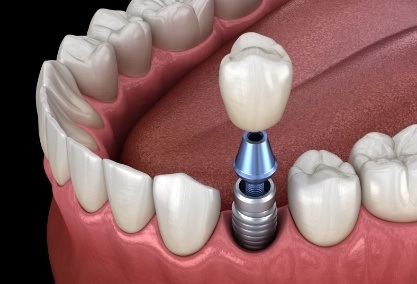
More than 120 million Americans are living with one missing tooth. To ensure our patients do not become a statistic, we can replace a single tooth with one dental implant. Using a titanium post, metal abutment, and customized dental crown, we can fill in the gap and restore optimal functionality.
Missing Multiple Teeth
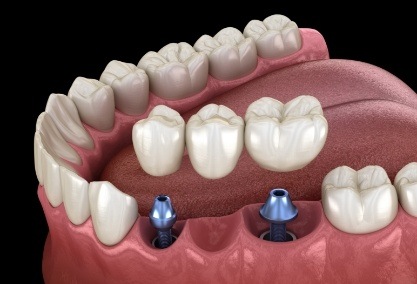
When two or more teeth are missing, we don’t need to resort to a traditional fixed bridge. Instead, we can avoid altering healthy tooth structures by using two implant posts to support a customized dental bridge. Placing the two posts into the exterior sockets will provide the necessary foundation for a bridge that can fill in the space and allow for greater bite force and chewing power.
Missing All of Your Teeth
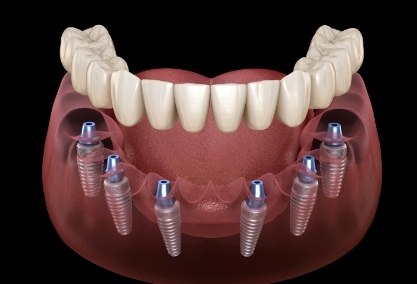
Instead of relying on a traditional denture to replace an entire arch of missing teeth, our team can use between four and six dental implants to set the foundation for a newly created implant denture. Secured with the help of these titanium posts, they require no denture adhesive or a person’s natural suction to remain in place.
Understanding the Cost of Dental Implants

The cost of dental implants cannot be determined until a person decides to come in for a scheduled consultation. It is during this visit that we will go over the various factors that can increase or decrease the amount spent on dental implants (i.e., the number of posts needed, the type of restoration, the need for preliminary treatments, etc.). Once we have an idea as to how much treatment will cost, we will formulate a cost estimate and go over available ways to pay.
Dental Implant FAQs
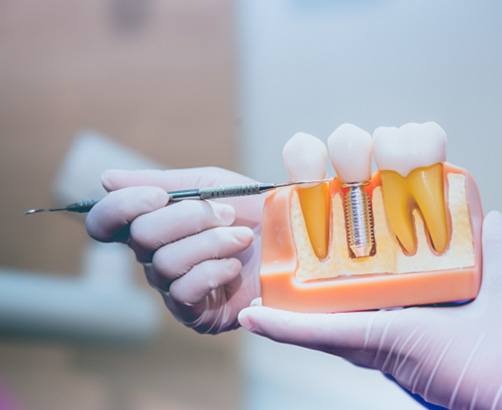
Can I Take Dental Implants Out?
Dental implants surgically fuse with the bone, and most of restorations you get will be surgically attached to them. As a consequence, dental implants cannot be removed except by a dental professional.
The only exception is so-called “snap on” implant dentures. They are designed to be removed from their dental implants for the purposes of cleaning.
Are Dental Implants Safe?
Dental implant surgery is remarkably low-risk for patients who are in otherwise good oral health. So long as you have them placed by trained professionals (like us), you can expect your treatment to be free from complications.
In order to make sure that your dental implant procedure is as safe as possible, we’ll perform a thorough examination of your smile to check for and treat any oral health problems that could cause issues. We’ll also review your medical history to make sure that you don’t have any conditions, like cancer or diabetes, that could make surgery a problem generally.
How Successful Are Dental Implants?
Dental implants have an incredibly high success rate. Around 95% of them not only succeed but are still successful at 20 years.
The overall rate of success of dental implants has a little bit to do with where they’re located in the mouth—dental implants replacing the molars are under greater pressure, and may therefore fail faster. However, the biggest threat to a dental implant is infection, which means that the best thing you can to do keep your implant in good condition would be to keep up with rigorous dental hygiene.
How Long Does It Take to Recover from Dental Implant Surgery?
Dental implant surgery is relatively low-impact, which means that most people can resume normal activities as soon as the day afterward. Bleeding should stop within the first couple of days, and you should be able to get through any discomfort with either prescribed or over-the-counter pain relievers.
You should, however, make it a point to avoid strenuous exercise for a week or so after the surgery. Increased blood flow can encourage bleeding, delaying the healing process.






